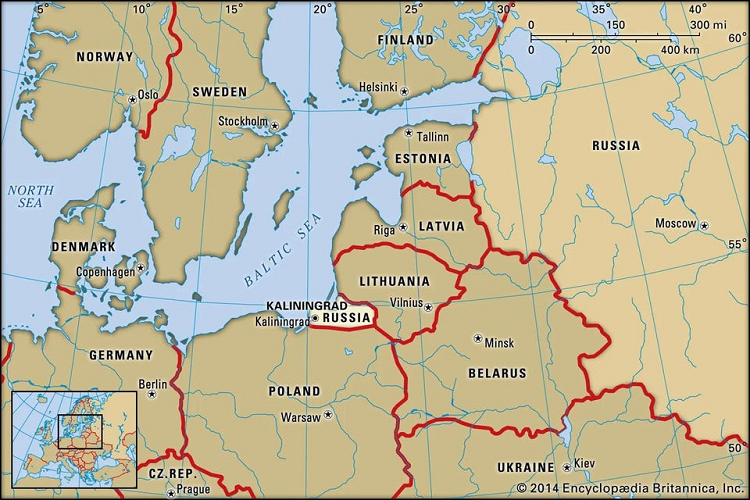12,000 RUSSIAN TROOPS DEFENDING KALININGRAD WENT TO UKRAINE TO DIE
 Six years ago, the Russian navy formed a new army corps whose job it would be to defend Kaliningrad, Russia’s geographically separate outpost on the Baltic Sea between Poland and Lithuania.
Six years ago, the Russian navy formed a new army corps whose job it would be to defend Kaliningrad, Russia’s geographically separate outpost on the Baltic Sea between Poland and Lithuania.
This year, when the war in Ukraine began to go badly for Russia, the Kremlin yanked the entire 11th Army Corps from Kaliningrad and sent it into Ukraine. Where the Ukrainian army quickly destroyed it.
The formation, deployment and destruction of the 11th Army Corps tell a story that’s bigger than the tragic tale of Russia’s war in Ukraine. The corps, sandwiched between two NATO countries along a strategic sea, was supposed to give Russian forces an advantage in a global war.
Instead, it became cannon fodder for a Ukrainian army that, on paper, was weaker than the Russian army was. Now Kaliningrad is all but defenseless, and the threat the oblast’s troops once posed to NATO … has evaporated.
The 11th Army Corps isn’t really a new formation. It’s a new grouping of existing formations under a single headquarters that itself answers to the Russian navy’s Baltic Fleet. The corps oversees a motorized division, a separate motorized regiment, artillery, rockets, air-defense troops and supporting units.
Before Russia widened its war in Ukraine starting in late February, there were no fewer than 12,000 Russian troops in Kaliningrad with around 100 T-72 tanks, a couple hundred BTR fighting vehicles, Msta-S howitzers and BM-27 and BM-30 rocket-launchers.
The 11th Army Corps oversaw most of these forces.
Looming on the western border of Lithuania, one of the weakest NATO member states, the 11th Army Corps was the anvil for a possible Russian invasion of the former Soviet republics Lithuania, Latvia and Estonia. The hammer was the 18,000-strong ground force in western Russia on the eastern border of the Baltic states.
NATO warily eyed the Kaliningrad buildup. “Kaliningrad certainly, historically, has been a place where we’ve been very attentive to the dynamics and the delicate regional situation,” a U.S. defense official told reporters in June.
Those dynamics radically changed after February. The Kremlin committed 80% of its ground forces to a wider invasion of Ukraine—and promptly lost many of them in a doomed bid to capture Kyiv.
Strung out along the roads leading to the capital, the poorly led, under-supplied Russian battalions, brigades and divisions were vulnerable to Ukraine’s artillery, drones and infantry teams hauling precision-guided anti-tank missiles.
After just a month of bitter fighting, the Russians retreated from Kyiv. Estimates vary, but it’s possible they suffered 50,000 killed and wounded by the time the front lines stabilized in May. The Russians at the time held the strategic port of Kherson in southern Ukraine and were on the outskirts of the free city of Kharkiv, 25 miles from the border with Russia in northeastern Ukraine.
But Russian forces were fragile. And getting more fragile as the Ukrainian army—rearmed with American and European artillery and rockets—began plucking at Russian supply lines. Desperate for fresh troops, the Kremlin mobilized the 11th Army Corps, moving it by ship and plane to Belgorod in southern Russia, then into Ukraine near Kharkiv.
Three months of grinding combat sapped the corps’ strength. Reuters got its hands on some of the 11th Army Corps’ paperwork. A spreadsheet dated August 30, right before a major Ukrainian counteroffensive, indicated the corps was at 71% of its full strength. Some battalions, however, were down to just a tenth of their original manpower.
It got worse for the corps. In late August and early September, the Ukrainian armed forces launched twin counteroffensives east of Kharkiv and north of Kherson. The Kharkiv operation, involving a dozen eager Ukrainian brigades, exposed profound weaknesses in the Russian forces in the area, including the 11th Army Corps.
Tens of thousands of Russians fled, surrendered or died in place as Ukrainian troops liberated a thousand square miles of Kharkiv Oblast in a heady two weeks. The 11th Army Corps suffered more than most Russian formations in the region. In late September, the Center for Strategic and International Studies in Washington, D.C., described the corps as “severely battered.”
That may have been an understatement. The Ukrainian general staff concluded the corps lost 200 vehicles and half of its troops in the counteroffensive.
It’s possible the 11th Army Corps survives. If so, it almost certainly will require many months to rest, re-equip and induct draftees in order to regain even a fraction of its former strength.
The deployment and subsequent destruction of the 11th Army Corps is a tragedy for the men who suffered and died under its command—and a terrible blow for the Russian war effort in Ukraine.
But the implications extend across Europe. The 11th Army Corps was supposed to defend Kaliningrad and threaten NATO’s eastern front. Now it can do neither.
David Axe is Forbes Magazine’s reporter covering Russia’s war in Ukraine.

